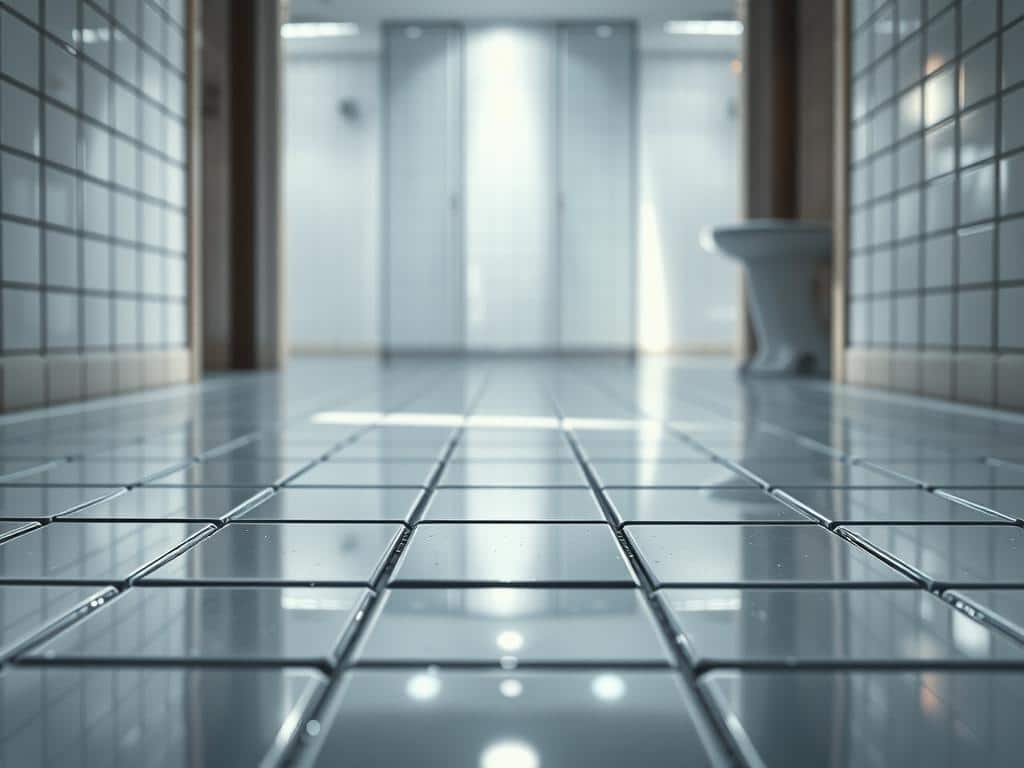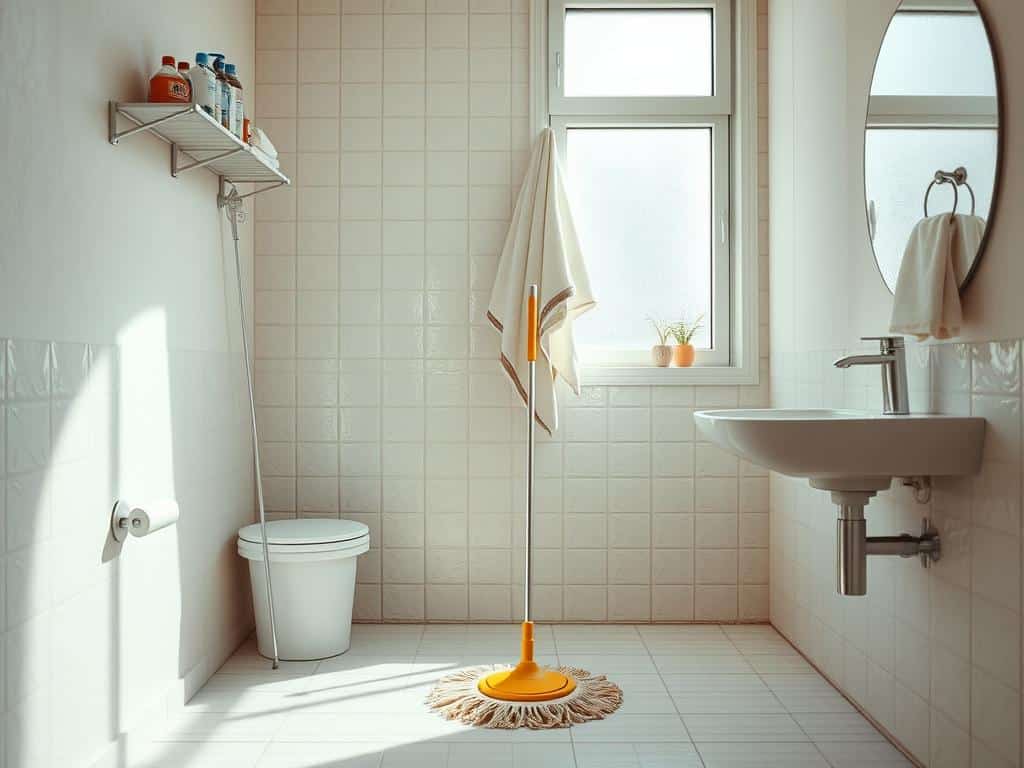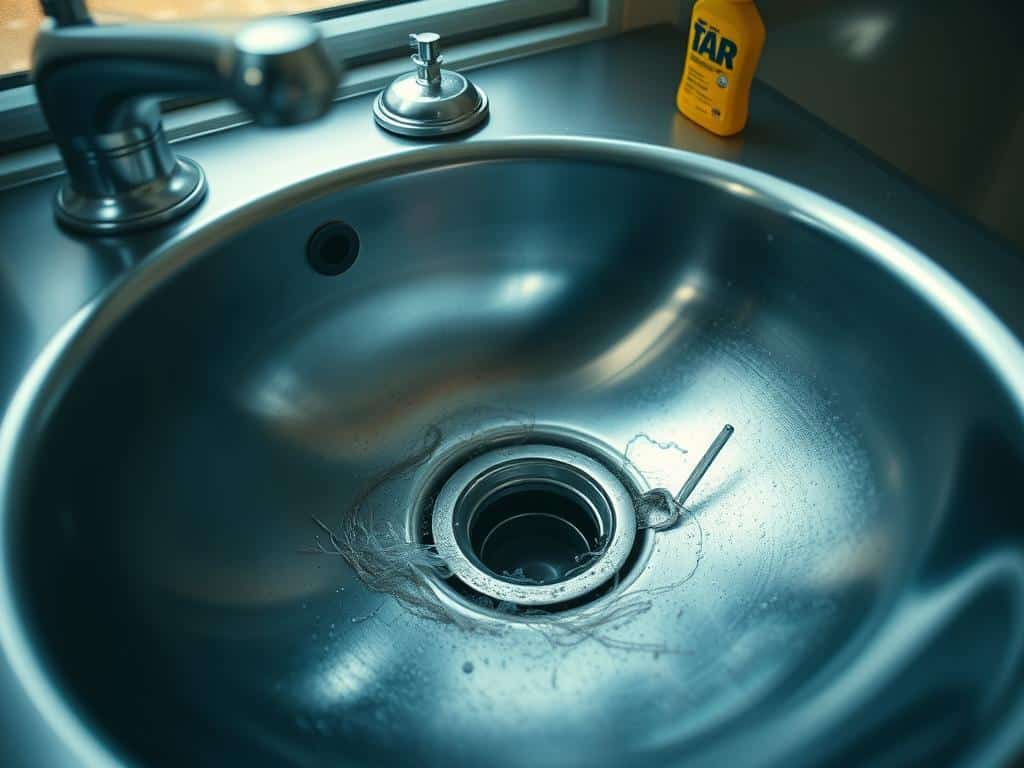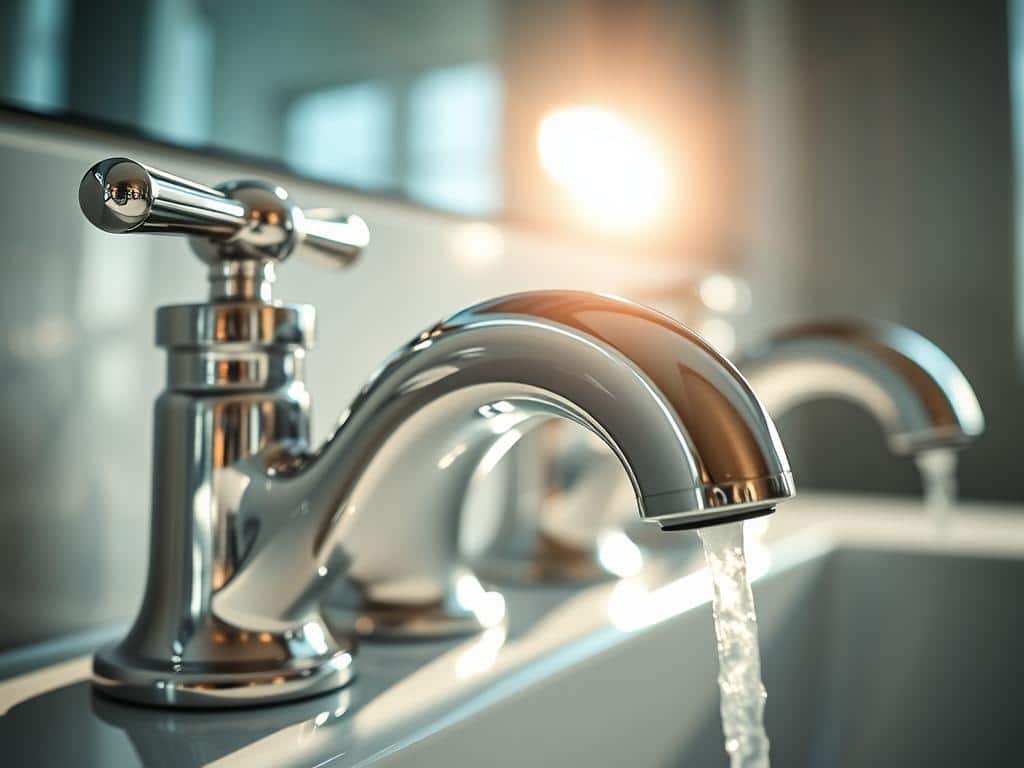
Keeping your bathroom floor tiles clean may seem tough, but it’s quite easy with the right steps. It’s important to know your tile type and follow the best cleaning tips. This keeps them looking good for longer. If you see a hazy film or dirty grout, it’s time for some special cleaning. Cleaning pro Grant Webster says using the correct method for your tile’s material is key.
Ceramic and porcelain tiles are tough and keep dirt off well. They stay in top shape with regular sweeping and mopping. But natural stone tiles like slate and marble need softer, special care to stay beautiful.
Vinyl tiles are tough and simple to care for, yet they also need their own cleaning routine. Dry and wet cleaning them often keeps them looking new. Experts also advise sealing grout every six months. This helps stop moisture and mold, keeping your tiles perfect.
Understand Your Tile Type
Knowing your tile type is key for its care and long life. Each kind, like ceramic, porcelain, and natural stone, needs its own care and cleaners. Experts like Grant Webster stress how vital it is to know the difference to prevent damage and clean well.
Ceramic and Porcelain Tiles
Ceramic and porcelain tiles are chosen often for their durability and simple care. Porcelain is less porous than ceramic, making it great for busy spots. The Porcelain Enamel Institute suggests using tiles with a hardness rating of 4 or more for home floors.
Carefully pick cleaning solutions for ceramic, especially for glazed tiles which are stain, scratch, and fade-resistant.
When picking between ceramic and porcelain, consider tile sizes, where you’ll use them, and how you want them to look. Sizes range from 12×12 to 18×18 inches. Porcelain is often denser and harder, making it more durable.
Natural Stone Tiles
Natural stone tiles, like marble, granite, and slate, bring luxury but need careful maintenance. They can’t handle harsh cleaners well. Avoid acidic cleaners for slate and protect marble from etching substances.
To keep natural stone looking good, seal it properly and use gentle cleaners.
Resilient Tiles
Resilient tiles, such as vinyl and linoleum, are flexible and wear-resistant. It’s important to know the condition of the tiles and their grout. Too much water or steam can damage them.
Choose pH-neutral cleaners and stay away from harsh tools to maintain your resilient tiles.
| Tile Type | Key Characteristics | Maintenance Tips |
|---|---|---|
| Porcelain | Durable, low porosity, suitable for high traffic | Use pH-neutral porcelain tile care products |
| Ceramic | Can be glazed or unglazed, resistant to stains and scratches | Regular sweeping and suitable ceramic cleaning solutions |
| Natural Stone | Luxurious, requires specialized maintenance | Use gentle stone tile maintenance products; avoid acids |
| Resilient | Flexible, resistant to wear | Use pH-neutral cleaners, avoid excessive water |
Prepare Your Cleaning Supplies
Getting ready to clean thoroughly begins with the right supplies. A detailed cleaning supply checklist includes everything needed. Tools, cleaners, and safety gear are part of this list. This helps keep your bathroom clean and makes a good impression.

Essential Tools You Need
For essential tools, a mop is a must. Choose a rag or chamois mop for certain tiles. A vacuum cleaner picks up loose dirt. A squeegee prevents water marks.
Microfiber products are great for a streak-free shine. Keeping your tools clean is key. Clean your brushes and toothbrushes well to stop germs.
Don’t forget about regular maintenance of your cleaning tools. This step is vital for a healthy space.
Choosing the Right Cleaners
The type of tile you have guides your cleaner choice. pH-neutral cleaners work well for most tiles. Consider eco-friendly options to lessen environmental impact.
Use specific solutions for natural stone tiles. Avoid harsh cleaners to protect your tiles.
Safety Precautions
Safety is crucial when cleaning. Follow basic bathroom safety tips like ensuring good air flow. This protects you from harmful fumes. Wear gloves to protect your hands.
Be careful with strong chemicals like bleach. They can harm you and your surfaces. Companies like Alsco offer maintenance services. They provide necessary supplies for a clean and safe bathroom.
How to Clean Bathroom Floor Tiles
Start by dry cleaning your bathroom floor tiles twice a week. This step combats dirt and bacteria build-up. Use a soft-bristle broom or a vacuum to pick up loose dirt. In high-traffic areas, consider cleaning more often or even hiring professionals.
After dry cleaning, wet clean the tiles once a week. Make a cleaning mixture based on your tiles. For ceramics and porcelain, warm water and mild detergent are best. You can use diluted vinegar for its disinfection power. Avoid strong chemicals to prevent tile damage.
To remove stains, first figure out what kind they are. Baking soda works well for common stains and cleaning grout. Make a paste with water, apply it on stains or grout, and let it sit overnight. For grout cleaning, use a bleach solution if needed but keep the area airy.
Keeping your bathroom clean is key for hygiene and to make tiles last longer. Having a cleaning schedule helps keep your bathroom nice and healthy. Experts suggest mixing natural and store-bought cleaners for the best routine.
Looking for more tile cleaning tips? Check out this Home Depot guide. And for a cleaner home, see these carpet cleaning tips.
Cleaning Ceramic and Porcelain Tiles
Looking after ceramic and porcelain tiles means knowing how to keep them looking great. These tiles are loved for being water, stain, and scratch resistant. But, keeping them in top shape needs a planned approach. This guide will show you how to mop without streaks, get rid of porcelain stains, and make ceramic tiles look new again.
Sweeping and Vacuuming
Start by getting rid of loose dirt. Small, gritty particles can make your tiles look dull, so it’s important to sweep and vacuum often. Use a soft-bristle broom or a vacuum set for hard floors. This will pick up dirt without harming your tiles. Sweeping well before you mop stops these small particles from scratching the tiles.
Mopping Techniques
Picking the right mop is key. A flat mop is best for these tiles, unlike a sponge mop that can push dirty water into the grout. Choose a cleaner that won’t harm the color or finish. Don’t let tiles air dry to avoid watermarks; dry them with a lint-free cloth for a shiny finish. Cleaning regularly with the right products keeps the tiles looking good and resistant to water.
Removing Stains and Residue
To get rid of porcelain stains, first figure out what caused them. For common stains, mixing vinegar and baking soda works well and saves money. If stains are stubborn, look for the right cleaners on the EPA’s list of disinfectants. Also, clean the grout with special cleaners to avoid dulling your tiles. After cleaning, dry the tiles with a lint-free cloth to keep them shiny and free of water spots.



